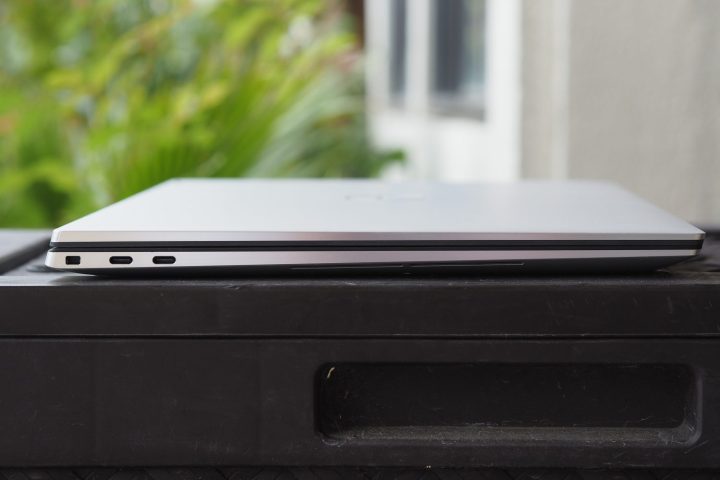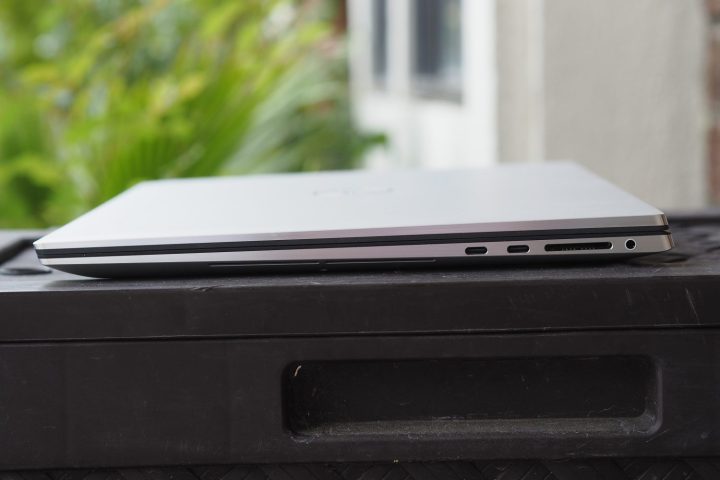Dell XPS 17 (2023) review: still great, but going a bit gray
MSRP $2,950.00
“The XPS 17 9730 is a disappointing update, and it’s losing its leadership position.”
Pros
- Solid productivity performance
- Good gaming performance
- Excellent build quality
- Great keyboard and touchpad
- Superior IPS display
- Classic design
Cons
- Dramatic drop in battery life
- Webcam is just 720p
- No Wi-Fi 6e
- Productivity performance unimproved
When Dell updated the XPS 15 for 2023, it upgraded to Intel’s 13th-gen CPUs and added a faster GPU with the RTX 4070. Otherwise, the laptop was unchanged and starting to show its age. With the newest XPS 17, Dell did the same thing, maintaining the tried-and-true design while upgrading the internals.
Both laptops are on our best-of lists for their respective sizes, 15-inch laptops and 17-inch laptops, but we’ll have to reconsider given the increased competition. The XPS 17 9730 is an incremental upgrade at best, and it’s no longer the no-brainer recommendation that it once was.
Specs and configurations
| Dell XPS 15 (9530) | |
| Dimensions | 14.74 inches x 9.76 inches x 0.77 inches |
| Weight | 5.37 pounds |
| Processor | Intel Core i5-13500H Intel Core i7-13700H Intel Core i9-13900H |
| Graphics | Nvidia GeForce RTX 4050 (60W) Nvidia GeForce RTX 4060 (60W) Nvidia GeForce RTX 4070 (60W) Nvidia GeForce RTX 4080 (60W) |
| RAM | 8GB DDR5-4800MHz 16GB DDR5-4800MHz 32GB DDR5-4800MHz 64GB DDR5-4800MHz |
| Display | 17.0-inch 16:10 Full HD+ (1,920 x 1,200) IPS 17.0-inch 16:10 4K+ (3,840 x 2,400) IPS |
| Storage | 512GB PCIe SSD 1TB PCIe SSD 2TB PCIe SSD 4TB PCIe SSD 8TB PCIe SSD (2 x 4TB SSDs) |
| Touch | Optional |
| Ports | 4 x USB-C with Thunderbolt 4 1 x 3.5mm audio jack 1 x SD Card reader |
| Wireless | Wi-Fi 6 and Bluetooth 5.2 |
| Webcam | 720p with infrared camera for Windows 11 Hello |
| Operating system | Windows 11 |
| Battery | 97 watt-hours |
| Price | $2,450+ |
Dell’s configuration options change often, but this isn’t an affordable laptop in any arrangement. Right now, the entry-level model available on its website is $2,450 for a Core i7-13700H, 16GB of RAM, a 512GB SSD, an Nvidia GeForce RTX 4050, and a 17.0-inch Full HD+ IPS display. My review unit with a Core i7, 32GB of RAM, a 1TB SSD, an RTX 4070, and a 4K+ IPS display is priced at $2,950. The most expensive configuration costs a whopping $5,200 for a Core i9-13900H, 64GB of RAM, 8TB of SSD storage (two 4TB SSDs), an RTX 4080, and a 4K+ IPS display. The XPS 17 is an expensive laptop from the low end to the high end, and runs in the same general price range as the Apple MacBook Pro 16.
A great design showing its age

I’ve always liked the aluminum and carbon or glass fiber combination in the XPS 15 and XPS 17 designs. It’s an elegant look, and the fiber palm rests provide a warm and inviting surface. But it also looks a bit dated beside the more all-aluminum design that just popped up on Dell’s XPS 13 lineup. The XPS 17 remains a great-looking laptop, and if you’re like me and appreciate its aesthetics, then you’ll be happy with the carryover. If you’re looking for something that looks more contemporary, then you’ll be disappointed that Dell made absolutely zero changes.
Interestingly, the XPS 17 is meant to be a thin and light laptop — and it is. The problem for Dell is that some other manufacturers are also making thin and light machines that pack in more power and don’t suffer from the same thermal limitations as the XPS 17 (see the performance section). The MSI Creator Z17 HX Studio, for example, also has a 17-inch display to go with its high-end components, and it’s thinner at 0.75 inches (versus 0.77 inches) and just slightly heavier at 5.49 pounds (versus 5.37 pounds). As we’ll see in the performance section, while the XPS 17 did better at gaming (surprisingly), it couldn’t keep up in productivity and creative applications. The LG Gram 17 Pro is an even thinner (0.70) and lighter (3.2 pounds) 17-inch machine, but it also runs much slower components.
You can’t complain about the build quality, though. The XPS 17 remains just as high-quality as always, with zero bending, flexing, or twisting. It’s easily the equivalent of the MacBook Pro 16, another well-built laptop, and you won’t find any other machine that exudes a more quality feel. The dual-clutch hinge opens smoothly and holds the display firmly in place, another aspect that evokes quality.
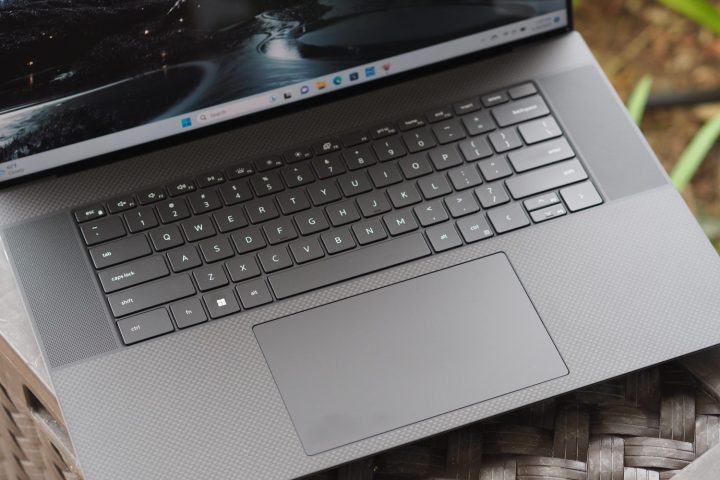
The keyboard remains the same, with lots of key spacing, nicely sized keycaps, and one of the lightest – yet snappiest — switches around. It’s almost as good as the best keyboard, Apple’s Magic Keyboard on its MacBook Pros, and that’s high praise. The touchpad is spacious and responsive, with solid, yet quiet clicks. It’s not as good as Apple’s Force Touch haptic touchpad, but it’s among the best mechanical touchpads on the market.
Connectivity is limited, with just three USB-C ports with Thunderbolt 4, an audio jack, and a welcome full-size SD card reader. Connectivity is behind the curve with Wi-Fi 6 and Bluetooth 5.2 rather than the newer Wi-Fi 6E standard. While many people aren’t even using Wi-Fi 6 yet, it’s a limitation that will eventually hold the XPS 17 back.
Also, the webcam remains just a 720p version, perhaps due to the extremely thin bezels. As such, it provides an inferior image compared to many other modern laptops and it won’t excite videoconferencers. An infrared camera allows Windows 11 Hello facial recognition, or you can use the fingerprint reader in the power button. Both worked well.
Productivity performance is unchanged while gaming improves

My review unit was equipped with the 45-watt Intel Core i7-13700H, a 14-core (six Performance at 5.0GHz and eight Efficient at 3.7GHz) and 20-thread CPU that’s been a solid productivity and creativity performer. The latter is especially true when the processor is paired with a discrete GPU like the RTX 4070 in my review unit. Of course, not all laptops are created equal, and the XPS 17 is aimed at being thin and light rather than providing the ultimate performance. Its thermal performance holds it back: Dell provides just 60W to the RTX 4070, which can run at up to 115W. That’s more than the 40W Dell allocated to the XPS 15 9530’s RTX 4070, but still not a lot of power.
In our CPU-intensive benchmarks, the XPS 17 was in line with other machines using the same CPU. Interestingly, it had faster single-core performance than the previous model with its 12th-gen Core i7-12700H CPU, but its multi-core performance was around the same. The XPS 17 did manage to beat the XPS 15, but it pretty closely matched the Samsung Galaxy Book3 Ultra, a thin and light 16-inch laptop. The XPS 17’s performance mode made a moderate difference in some benchmarks and is worth turning on.
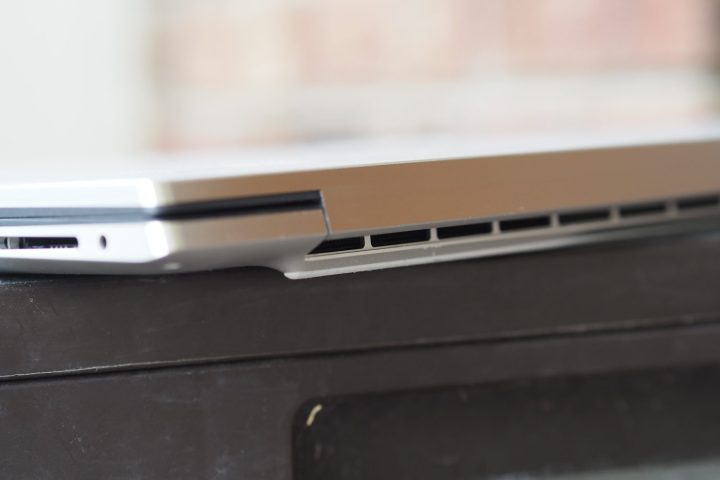
Where the XPS 17 was least impressive was running the PugetBench Premiere Pro benchmark, which runs in a live version of Adobe’s Premiere Pro and utilizes the GPU to accelerate a variety of tasks. Here, the XPS 17 9730 fell behind the previous model (9720) and couldn’t keep up with the XPS 15 or Galaxy Book3 Ultra in performance mode. It was also considerably slower than the Apple M2 Max CPU in the MacBook Pro 14, which doesn’t bode well for its performance relative to the MacBook Pro 16 M2 (which we haven’t tested).
The XPS 17 is a fast 17-inch laptop for demanding productivity users, and it can do some creative work as well. It’s just not all that impressive compared to other thin and light laptops, including the previous model, and it doesn’t stand up well against faster 17-inch machines like the MSI Creator Z17 HX Studio. It’s important to remember that you’re buying a thin and light laptop with the XPS 17, not a performance powerhouse.
| Geekbench (single / multi) |
Handbrake (seconds) |
Cinebench R23 (single / multi) |
Pugetbench Premiere Pro |
|
| Dell XPS 17 9730 (Core i7-13700H / RTX 4070) |
Bal: 1,901 / 12,654 Perf: 1,928 / 12,911 |
Bal: 79 Perf: 71 |
Bal: 1,933 / 13,384 Perf: 1,912 / 15,462 |
Bal: 760 Perf: 848 |
| Dell XPS 17 9720 (Core i7-12700H / RTX 3060) |
Bal: 1,712 / 13,176 Perf: 1,747 / 13,239 |
Bal: 74 Perf: 71 |
Bal: 1,778 / 12,696 Perf: 1,779 / 14,086 |
Bal: 771 Perf: 853 |
| LG UltraPC 17 (Core i7-1360P / RTX 3050 Ti) |
Bal: 1,598 / 7,444 Perf: 1,595 / 8,915 |
Bal: 146 Perf: 107 |
Bal: 1,619 / 6,454 Perf: 1,697 / 9,316 |
Bal: 633 Perf: 651 |
| Dell XPS 15 (9530) (Core i7-13700H / RTX 4070) |
Bal: 1,787 / 11,978 Perf: 1,830 / 11,769 |
Bal: 79 Perf: 76 |
Bal: 1,865 / 13,386 Perf: 1,868 / 13,927 |
Bal: 709 Perf: 1.032 |
| Samsung Galaxy Book3 Ultra (Core i7-13700H / RTX 4050) |
Bal: 1,647 / 12,206 Perf: 1,815 / 12,307 |
Bal: 80 Perf: 74 |
Bal: 1,712 / 13,278 Perf: 1,908 / 14,938 |
Bal: 737 Perf: 975 |
| MSI Creator Z17 HX Studio (Core i9-13950HX / RTX 4070) |
Bal: 2,005 / 15,786 Perf: 2,006 / 19,894 |
Bal: 61 Perf: 51 |
Bal: 1,968 / 19,992 Perf: 2,024 / 23,935 |
Bal: 725 Perf: 1,193 |
| Apple MacBook Pro 14 (M2 Max 12/38) |
Bal: 1,973 / 14,596 Perf: N/A |
Bal: 85 Perf: N/A |
Bal: 1,608 / 14,789 Perf: N/A |
Bal: 1,222 Perf: N/A |
The increase in GPU power available with the XPS 17 9730 is a more significant improvement than the upgrade in CPU. You can now configure up to an RTX 4080, although doing so is unlikely to bring you the improvements you want, given the laptop’s thermal limitations. As it is, the RTX 4070 in the new generation is faster than the previous model’s RTX 3060 and provides increases across the board in our gaming benchmarks.
Surprisingly, the XPS 17 beat out some other laptops with the same GPU, and it was even faster than the RTX 3080 Ti in the MSI Creator Z16P — although that machine was notoriously slow at gaming during our testing. Overall, the XPS 17 did well at 1080p and might be able to play at 1440p, if you don’t turn the graphics up too high.
| Assassin’s Creed Valhalla (1080p Ultra High) |
Cyberpunk 2077 (1080p Ultra) |
Civilization VI (1080p Ultra) |
3DMark Time Spy |
|
| Dell XPS 17 9730 (Core i7-13700H / RTX 4070) |
Bal: 88 fps Perf: 94 fps |
Bal: 75 fps Perf: 77 fps |
Bal: 155 fps Perf: 159 fps |
Bal: 9,639 Perf: 9,535 |
| Dell XPS 17 9720 (Core i7-13700H / RTX 3060) |
Bal: 23 fps Perf: N/A |
Bal: 45 fps Perf: N/A |
Bal: 111 fps Perf: N/A |
Bal: 6,757 Perf: 6,958 |
| Dell XPS 15 9530 (Core i7-13700H / RTX 4070) |
Bal: 65 fps Perf: 105 fps |
Bal: 60 fps Perf: 60 fps |
Bal: 131 fps Perf: 137 fps |
Bal: 7,077 Perf: 7,632 |
| MSI Creator Z17 HX Studio (Core i9-13950HX / RTX 4070) |
Bal: 66 fps Perf: 101 fps |
Bal: 61 fps Perf: 90 fps |
Bal: 149 fps Perf: 191 fps |
Bal: 10,186 Perf: 11,630 |
| MSI Creator Z16P (Core i9-12900H / RTX 3080 Ti) |
Bal: 55 fps Perf: 60 fps |
Bal: 30 fps Perf: 49 fps |
Bal: 60 fps Perf: N/A |
Bal: 9,251 Perf: 10,054 |
A creator’s IPS display
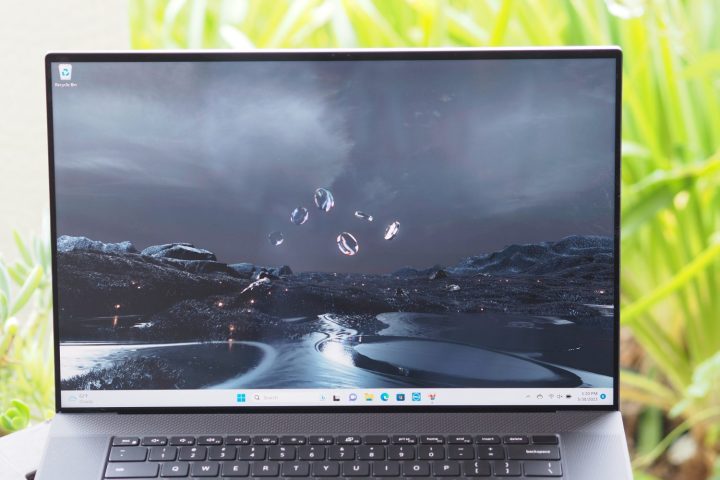
Many creative laptops are equipped with OLED and mini-LED displays that offer superior brightness, contrast, and colors. Dell stuck with an excellent IPS 4K+ display for the XPS 17 9730, and it’s a winner for creators. It’s bright at 501 nits and enjoys a 1,570:1 contrast ratio, which is excellent for IPS, even if it doesn’t match the inky blacks of the other leading technologies. The colors are excellent, with 100% sRGB and 100% AdobeRGB gamut coverage and an accuracy of DeltaE 1.33 (just missing the 1.0 or less cutoff for an excellent panel).
We’d prefer that Dell updated to either OLED or mini-LED, but the display it used will still make creators, productivity users, and media consumers quite happy.

As with the previous version, the XPS 17 9730 pumped out excellent audio thanks to a four-speaker setup, with two upward-firing speakers alongside the keyboard and two side-firing speakers along the chassis. It’s among the best audio you’ll find on a Windows laptop, with plenty of volume, clear mids and highs, and some bass. It can’t quite match the superior audio of the MacBook Pro 16, but it’s still excellent.
A surprising drop in battery life
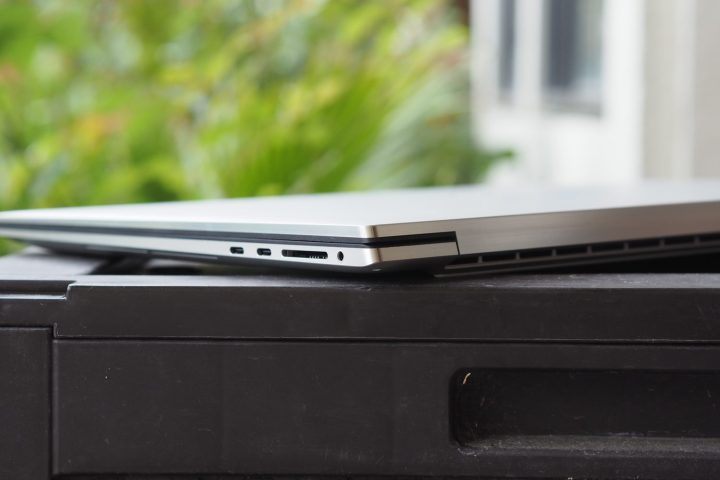
The XPS 17 9730 has exactly the same battery capacity as the previous model, and a CPU that should be at least as efficient, if not more so. When compared with the previous model, however, which also used the same 4K+ display, the newer machine saw a dramatic reduction in battery life.
It fell almost three hours in our web-browsing test, eight hours in our video-looping test, and 1.5 hours in the PCMark 10 Applications battery benchmark. It was way behind our comparison group, and is unlikely to last even half a day when performing typical productivity tasks.
I’m not sure why battery life is so much worse, but these results are disappointing.
| Web browsing | Video | PCMark 10 Applications |
|
| Dell XPS 17 9730 (Core i7-13700H) |
4 hours, 46 minutes | 5 hours, 17 minutes | 5 hours, 34 minutes |
| Dell XPS 17 9720 (Core i7-12700H) |
7 hours, 36 minutes | 13 hours, 5 minutes | 7 hours, 3 minutes |
| LG Gram Style (Core i7-1360P) |
8 hours, 37 minutes | 9 hours, 23 minutes | 9 hours, 7 minutes |
| Dell XPS 15 9530 (Core i7-13700H) |
9 hours, 43 minutes | 11 hours, 46 minutes | 10 hours, 49 minutes |
| LG Gram 17 Pro (Core i7-1360P) |
13 hours, 43 minutes | 19 hours, 53 minutes | N/A |
| LG UltraPC 17 (Core i7-1260P) |
9 hours, 49 minutes | 11 hours, 54 minutes | 13 hours, 26 minutes |
| Lenovo ThinkPad Z16 (Ryzen 7 Pro 6850H) |
12 hours, 4 minutes | 23 hours, 2 minutes | N/A |
Barely treading water
The XPS 17 9730 is an underwhelming update. Don’t misunderstand me – it’s still a very good laptop, providing solid performance in a thin and light package. But it’s falling behind, with slower creativity performance than many other 17-inch laptops, and it’s saddled with older technologies like a 720p webcam and wireless connectivity that’s a generation behind.
It’s also expensive, rivaling the much stronger MacBook Pro 16 depending on the configuration. If you’re looking for a 17-inch laptop, then the XPS 17 remains a viable choice. But it’s no longer the class leader that it once was.
Editors’ Recommendations


